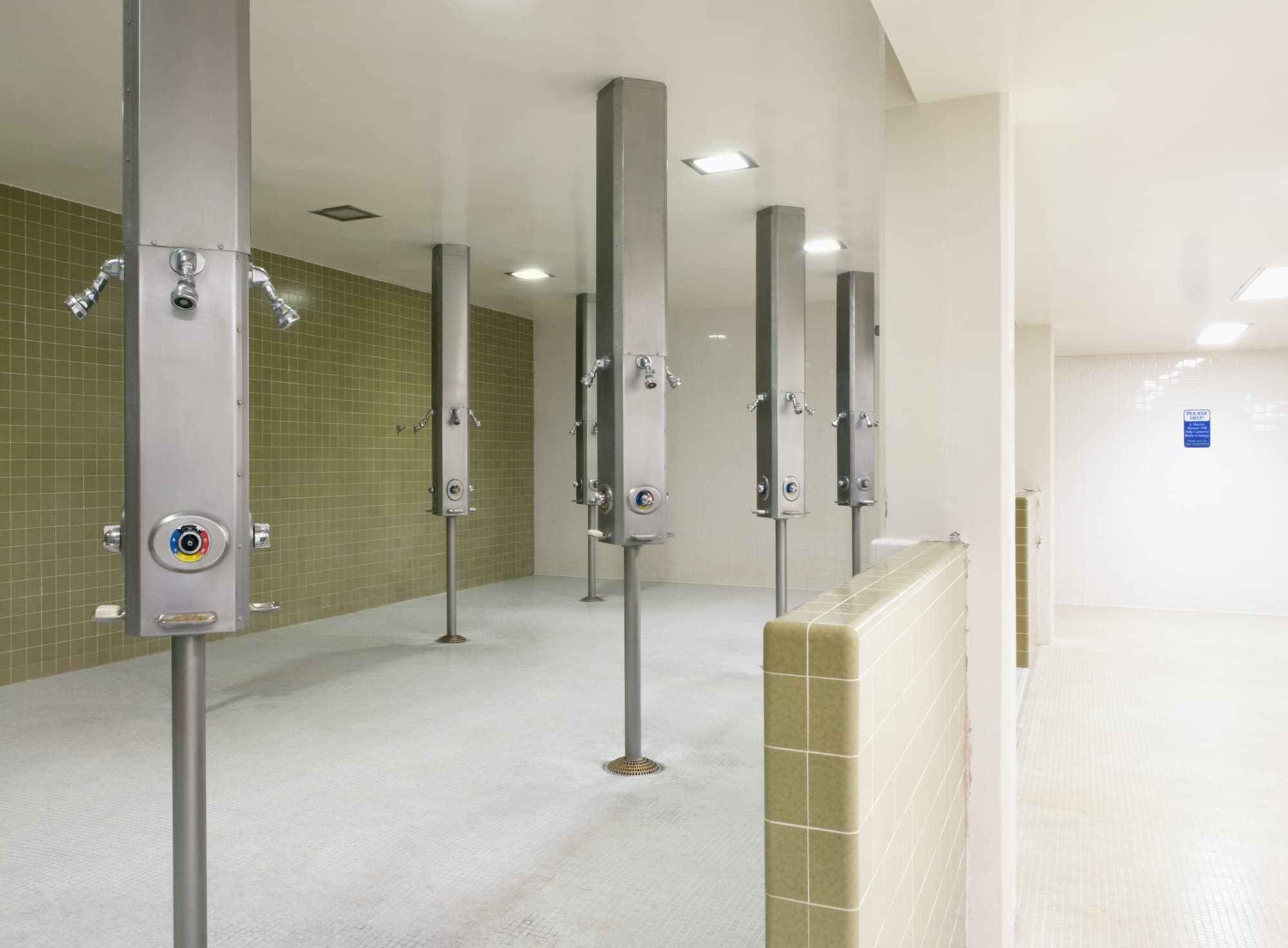You should definitely wear shower shoes at the gym. Many fungi are most commonly found in areas that are moist and warm, which is exactly how one might describe their gym locker room.
The most typical type of fungus you might encounter at a gym is dermatophyte, which causes athlete’s foot. The easiest way to get an athlete’s foot is skin contact with a contaminated surface.
Speaking of bacteria and fungus, Emily McKenzie, M.D. told the University of Utah Health that after someone with contaminated feet makes skin contact with a shower, “the organisms then continue to live in a warm, moist, dark, environment, then you pick them up when you shower.”
Dangerous bacteria like MRSA (Methicillin-resistant Staphylococcus aureus), and other types of Staphylococcus are also often found in gyms. In a study that collected samples from fitness centers in Memphis, TN, they found that Staphylococcus was the most common bacteria on tested surfaces.

The bacteria was found on almost 100% of the power striders, followed by the elliptical machines and the nautilus machines, and so on.
Other infections that can be transferred easily from a shared surface include wart viruses. If you have cuts or blisters on your feet and walk barefoot into a contaminated shower, you are likely to pick the virus up. While not dangerous, warts are often undesired and can occasionally be painful when growing on the sole of the foot.
Because of the presence of certain fungi, bacteria, and infections, it is important that you protect yourself in all areas of the gym, both through disinfecting gym surfaces, avoiding skin contact as much as possible and most easily wearing shower shoes in the gym showers.
The best way to minimize your contact with potentially contaminated shower surfaces is by investing in a good pair of shower shoes. Because it is so easy to pick up bacteria and fungus from a contaminated surface, if you are going to use a shared shower you should definitely be avoiding direct skin contact.
Additionally, wearing shoes that were made specifically for showering is important. You need to make sure you can keep your shoes dry in between uses, so the waterproof rubber shower shoes are made of is the best way to go.
What are Shower Shoes?
Shower shoes are shoes that are fully waterproof, airy, and easy to dry. They are typically made of rubber or plastic, as both materials are sturdy, long-lasting, and easy to clean.
They come in a few different styles, and depending on your budget and your personal aesthetic, there is something for everyone.
Some things to look for in shower shoes include:
- Good grip
- Rubber, or other easily dried material
- Chlorine resistance
- Anti-microbial material or coating
Shower shoes should have a good grip to allow you to safely walk on wet, slippery surfaces. Look for a shower shoe that has slip resistance.
Some shower shoes are made of anti-microbial compounds or have an anti-microbial coating. Anti-microbial protection will work to either inhibit growth or sometimes even kill microorganisms. These shoes will give an extra layer of protection between a bacteria or fungi ridden floor and your feet.
Chlorine resistant shower shoes will make your shower shoes last longer if they are often in the presence of chlorine. It can be worth it to look for a pair of shower shoes with this quality if you are going to be at the pool often.
Types of Shower Shoes
Slide
Shower slides are designed to be open-toed, with a strip of rubber over the top of your foot holding them on. Nothing goes between your toes, and some will have one solid strip, while others have holes or multiple strips to allow for water to get in and out, as well as a potentially faster dry-time.
Slipper
A shower slipper basically has the same look and function as a shower slide, just with a different name. A solid strip of rubber runs over the top of the foot, with nothing between your toes, or behind your heel. As the name implies, you can slip it on and off easily.
Sandal
Shower sandals cover a wide range of designs, including the rubber strip look of the slide or slipper, the y-strap, or any arrangement of straps that allow you to easily put them on or take them off.
Flip Flop
Flip flops are a type of shower sandal that has a “y-strap.” A y-strap is two thin rubber parts that start on either side of the shoe and meet together at the top of the shoe, forming a “toe thong” in between your first and second toes. It slips on and off easily but is more loose-fitting than a slide, and the toe thong might take some getting used to.
Crocs
Crocs became well-known for their all-rubber, close-toed, slip-on shoe with a heel strap. While they can be a slightly more expensive option, they are great if you want the security of a more formed shoe, with the convenience of that shoe being airy and waterproof.
In contrast, you do want to be able to fully wash your foot of anything that may have begun breeding in your sweaty, dark shoe while you were working out. Make sure that if you wear a full croc, you can still get your foot fully washed.
Do I Need Shower Shoes at the Pool
Yes, you should use shower shoes at the pool. A pool can be a breeding ground for bacteria and fungus. While public pools are usually chlorinated for hygiene and disinfectant purposes, bacteria can still grow in the grout around pool tiles, and the cement areas around the pool are not necessarily bacteria-free either.
Wearing some type of shower shoe is better than a tight-fitting swim shoe, or even a shoe like a Teva that is made of semi-absorbent materials. Continuing to wear a swimming shoe after you have gotten out of the pool can lead to your foot remaining moist and warm, creating a fantastic environment for bacteria and fungus.
Tevas, while airy, will take longer to dry than a rubber shower shoe. In order to potentially reduce the risk of exposing your skin to bacteria or fungus, a shower shoe is the best way to go.
How to Clean Shower Shoes
Dermatologist John Christopher Trinidad, M.D., M.P.H., recommend disinfecting your shower shoes often, as well as keeping them clean and drying them out fully.
You should also transport your shower shoes in a separate bag from your other gym equipment or personal items, to avoid cross-contamination. Make sure to remove your shoes from their bag as soon as possible to both fully disinfect them and let them dry out.
There are a few different methods for disinfecting and cleaning your shower shoes:
| Disinfectant | How often | Tips & Tricks |
| Anti-microbial soap | After every use | Use warm water mixed with anti-microbial soap to fully clean shoes |
| Bleach | Bleach can be hard on a surface, so use in addition to anti-microbial soap, once every few weeks or so. | Make sure to heavily dilute your bleach with water – a 1:10 ratio of bleach to water at most If you have sprayed your shoes with anything, read the bottle closely to make sure nothing in the spray might react dangerously with the bleach |
| Disinfectant or anti-fungal spray | After every use | Sprays are a good option if you can’t get home right after the gym Use in conjunction with anti-microbial soap to make sure all the nooks and crannies of your shoes are clean |
| Rinsing with water at the gym | Every gym visit – after you wash your feet, and after you’ve changed into your street shoes | Rinse your shower shoes with water before you put them into their personal bag for transport – make sure to follow up at home with another method |
The most effective and easiest way to clean your shower shoes is with anti-microbial soap. You can easily make sure every bit of your shoe is disinfected, and you probably already have the soap on hand.
Bleach is a great method as long as you aren’t doing it every day. Also make sure you read all the labels of anything you put on your shoes prior to using bleach, as it can react with certain chemicals to create dangerous gasses.
Disinfectant spray and rinsing with water at the gym can happen every day, and you can even carry disinfectant spray with you in your gym bag. It is a convenient way to keep your shoes as clean as possible until you can give them a thorough disinfecting.
Lastly, an important step in making sure your shoes stay clean is to allow them to dry out between uses. If you often shower at the gym or spend most days at the pool, you might think about investing in two pairs of shower shoes so you can alternate them and allow them plenty of time to dry between uses.
How Often Should you Replace Shower Shoes
How often to replace your shower shoes depends on the material they are made out of, and how often you use them.
Most shower shoes are made of sturdy and long-lasting materials such as rubber or plastic and will last you at least a year or more of regular use.
You should replace your shower shoes if:
- The grip on your sole is wearing out
- Your straps are coming loose
- You are experiencing pain from use
One of the most important features of your shower shoes is going to be their slip resistance. If you notice that the treads on your shoes are wearing down, or that you are feeling less steady on your feet, you should replace your shoes as soon as possible to lower your risk of falling and injury.
Similarly, the straps of your shoes are going to keep you steady, and if you have a pair of shower shoes that are not all one piece (as some slides are), you may find that your straps are starting to come loose after some use, making them less safe to wear in a wet environment.
Many shower shoes are designed to be comfortable. If you have never experienced foot pain while wearing them but you have recently started to, it could be an indication that the form and soles are wearing out and causing them to not adequately support your feet.
Shower shoes are useful in many different shared water environments, and they are definitely worth the investment. Whether you and your roommates are using the same shower, or you use the shower or pool at the gym, getting a pair of shower shoes can help keep you safe from the many bacteria and fungi that thrive in any wet, trafficked environment, no matter how clean it looks to the naked eye.
Source:
https://wexnermedical.osu.edu/blog/good-idea-to-wear-flip-flops-at-public-showers
https://www.ncbi.nlm.nih.gov/pmc/articles/PMC4276630/
https://healthcare.utah.edu/healthfeed/postings/2018/04/shower.feet.php

Austin is the author of loveatfirstfit.com and a personal trainer with extensive knowledge in nutrition. Austin is passionate about helping others to find a suitable healthy lifestyle and feel good about themselves. Austin’s goal is to help people push their limits and achieve their physical performance.

